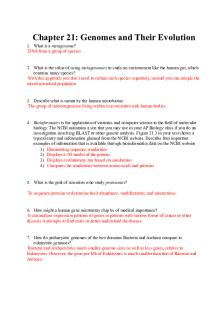Guided Reading Chapter 7 PDF

| Title | Guided Reading Chapter 7 |
|---|---|
| Author | Ellie Henry |
| Course | How Things Work |
| Institution | University of North Carolina at Chapel Hill |
| Pages | 2 |
| File Size | 72.8 KB |
| File Type | |
| Total Downloads | 73 |
| Total Views | 144 |
Summary
guided reading...
Description
Chapter 7.1: Woodstoves Vocabulary (short definition/use in a sentence) • • • • • • •
• •
• •
•
Thermal equilibrium o Possessed by two objects with the same temperature Heat o Thermal energy on the move Chemical reaction o Thermal energy is released by a chemical reaction between molecules Activation energy o The energy needed to initiate the chemical reaction Heat exchanger o A device that transfers heat without transferring the hot molecules themselves Conduction o Occurs when heat flows through a stationary material Thermal conductivity o The measure of how rapidly heat flows through a material when it is exposed to a difference in temperatures Convection o Occurs when a moving fluid transports heat from a hotter object to a colder object Radiation o Unlike conduction and convection, radioactive heat does not depend on atoms/molecules/electrons to carry heat o Occurs in space, when two objects are touching each other Electromagnetic waves o Mechanisms of heat transfer Heat capacity o The amount of heat that must be added to an object to increase its temperature by 1 unit Specific heat o Quantity that measures a material’s heat capacity per unit mass
Units (what quantity is measured in the following) • •
J/(kg K) o Unit of thermal heat W/(m*K) o Unit of thermal conductivity
Equations and physical laws (express in words) •
Specific Heat
o
Equal to heat capacity / mass
Example problems/questions: 1. You put your leftovers after dinner into the refrigerator. Which way is heat flowing? Is this a heat exchanger? a. Heat flows naturally from warm objects to cold objects, so in this case the leftovers in the fridge are losing heat. In this case, the heat exchanger in the fridge itself. 2. You make a batch of cookies by placing a sheet tray on the shelf in the middle of your oven. Describe the heat transfer processes by which the cookies bake. a. The cookies are baked by radiation, where the heaters in the oven radiate energy and warm up the cookies. 3. You can use a blender to crush ice cubes, but if you leave it churning too long, the ice will melt. What supplies the energy needed to melt the ice? a. The friction created between the ice cubes and the blender, as well as the mechanical energy generated by the blender, warm up the contents of the blender. In this case, that is why the ice begins to melt....
Similar Free PDFs

Guided Reading Chapter 7
- 2 Pages

Chapter 13 Guided Reading
- 5 Pages

Chapter 8 Guided Reading
- 3 Pages

Guided Reading Chapter 2
- 2 Pages

Chapter 21 Guided Reading
- 5 Pages

Guided Reading Chapter 24
- 3 Pages

Guided Reading Chapter 9
- 8 Pages

Amsco Guided Reading Chapter 3
- 9 Pages

Amsco Guided Reading Chapter 4
- 9 Pages

Guided Reading Questions #5
- 2 Pages

Guided Reading Assignment #2
- 2 Pages

Bio guided reading 11
- 6 Pages

Guided Reading #2 - GRQ
- 1 Pages

Chapter 20 guided reading bif 1
- 2 Pages
Popular Institutions
- Tinajero National High School - Annex
- Politeknik Caltex Riau
- Yokohama City University
- SGT University
- University of Al-Qadisiyah
- Divine Word College of Vigan
- Techniek College Rotterdam
- Universidade de Santiago
- Universiti Teknologi MARA Cawangan Johor Kampus Pasir Gudang
- Poltekkes Kemenkes Yogyakarta
- Baguio City National High School
- Colegio san marcos
- preparatoria uno
- Centro de Bachillerato Tecnológico Industrial y de Servicios No. 107
- Dalian Maritime University
- Quang Trung Secondary School
- Colegio Tecnológico en Informática
- Corporación Regional de Educación Superior
- Grupo CEDVA
- Dar Al Uloom University
- Centro de Estudios Preuniversitarios de la Universidad Nacional de Ingeniería
- 上智大学
- Aakash International School, Nuna Majara
- San Felipe Neri Catholic School
- Kang Chiao International School - New Taipei City
- Misamis Occidental National High School
- Institución Educativa Escuela Normal Juan Ladrilleros
- Kolehiyo ng Pantukan
- Batanes State College
- Instituto Continental
- Sekolah Menengah Kejuruan Kesehatan Kaltara (Tarakan)
- Colegio de La Inmaculada Concepcion - Cebu

